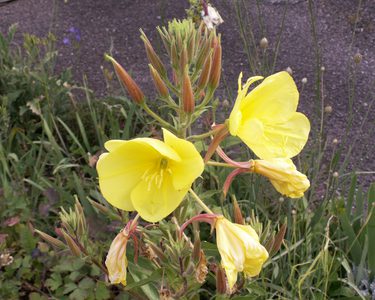Evening-primrose

Other names
Latin names
Oenothera Spp.
Weed Type
Biennial Weeds
Where would I find evening-primrose?
Fifteen species of evening-primrose have been recorded in Britain. Only 4 are common: the large-flowered evening-primrose (O. glazioviana), the common evening-primrose (O. biennis), the small-flowered evening-primrose (O. cambrica) and the fragrant evening-primrose (O. stricta). The other species occur as non-persistent introductions from America. Hybrids between the different species also occur. The hybrids are fertile and may backcross and form triple-hybrids. Hybridisation and the misidentification of species means that records in Britain are not always reliable. Some plant characters are variable which adds to the confusion.
Common evening primrose is a winter annual or biennial found on roadsides, railway tracks and waste places especially on light-sandy or gravely soils. It may also be a weed of meadows, pastures, vineyards, fruit crops and neglected fields. Common evening primrose was thought to be a mainland European species but probably arrived there from North America in the 17th century and then spread to Britain in the 19th century. It was well established on sandhills along the Somerset coast in 1905 having been first recorded there in 1837. Populations of common evening-primrose consist of many different but intergrading biotypes. It is able to tolerate drought conditions.
Fragrant evening-primrose is from Chile and is annual or biennial. It was seen on sandhills near Weston-super-Mare around 1883, however, herbarium records suggest it was present near Burnham in 1859.
The large and small-flowered evening-primrose are from North America and are usually biennial. The small-flowered evening primrose was probably introduced from Canada in the 18th century and became established in dunes and waste places in South Wales.
The young leaves of the common evening-primrose can be eaten as a salad. The fleshy roots are also edible as a cooked vegetable. The seeds are rich in beta-linolenic and gamma-linoleic acids that have important medicinal and therapeutic uses. Evening-primrose is cultivated as an oilseed crop using strains with a high oil content. The shedding of ripe seeds by evening-primrose prior to and during crop harvest can be extensive leading to its appearance as a volunteer weed in following crops.
Biology
The various evening-primrose species flower from June to September. The flowers open in the evening and die within 24 hours. Common evening-primrose flowers are predominately self-pollinated but out-crossing can occur. Seeds are produced in mid-August. Common evening-primrose plants produce an average of 140 capsules each containing 160-180 seeds. Seed numbers per plant range from 25,200 to 118,500. The plants die after setting seed.
Seed germination takes place mainly in spring. Exposure to light, abrasion and hot water improves germination. Seeds of common evening-primrose do not germinate if buried deeper than 5 mm in soil. Seedlings emerge and establish best in bare ground.
New growth from the overwintered rosettes begins in late spring. Rosettes need to reach at least 3 cm diameter before the onset of winter in order to become vernalised and able to flower the following year.
Does evening-primrose spread easily?
The longevity of common evening-primrose seeds in soil has been given as 50 or more years.
How to manage evening-primrose organically
Ploughing buries the rosettes and prevents flowering. Hoeing, pulling or mowing before seed is set will also reduce future weed populations. However, decapitated seedlings are reported to regrow from adventitious buds on the hypocotyl.
The seeds are eaten by various birds. A number of insect species feed on common evening-primrose leaves, flower buds and seeds. It can also become infected by certain strains of downy mildew.